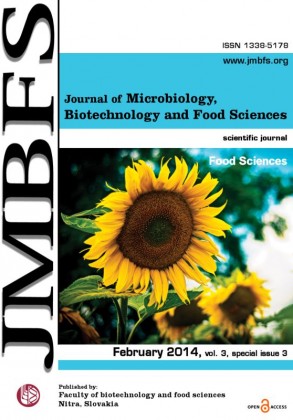BREAD CRUMBS TEXTURE OF SPELT
Keywords:
spelt, crumb texture, bread, firmness, stiffness, relative elasticityAbstract
Texture analysis is an objective physical examination of baked products and gives direct information on the product quality, oppositely to dough rheology tests what inform on the baking suitability of the flour, as raw material. Evaluation of the mechanical properties of bread crumb is important not only for quality assurance in the bakeries, but also for assessing the effects of changes in dough ingredients and processing condition and also for describing the changes in bread crumb during storage. Crumb cellular structure is an important quality criterion used in commercial baking and research laboratories to judge bread quality alongside taste, crumb colour and crumb physical texture. In the framework of our research during the years 2010 – 2011 were analyzed selected indicators of bread crumb for texture quality of three Triticum spelta L. cultivars – Altgold, Rubiota and Ostro grown in an ecological system. The bread texture quality was evaluated on texture analyzer TA.XT Plus (Stable Micro Systems, Surrey, UK), following the AACC (74-09) standard and expressed as crumb firmness (N), stiffness (N.mm-1) and relative elasticity (%). Our research proved that all selected indicators were significantly influenced by the year of growing and variety. The most soft bread was achieved in Rubiota, whereas bread crumb samples from Altgold and Ostro were the most firm and stiff. Correlation analysis showed strong negative correlation between relative elasticity and bread crumb firmness as well as bread stiffness (-0.65++, -0.66++). The spelt wheat bread crumb texture need further investigation as it can be a reliable quality parameter.Downloads
Downloads
Published
2014-02-01
How to Cite
Korczyk – Szabó, J., & Lacko – Bartošová, M. (2014). BREAD CRUMBS TEXTURE OF SPELT. Journal of Microbiology, Biotechnology and Food Sciences, 3(special issue 3 (Food Sciences), 244–246. Retrieved from https://office2.jmbfs.org/index.php/JMBFS/article/view/7584
Issue
Section
Food Sciences
License
Copyright (c) 2014 Joanna Korczyk – Szabó, Magdaléna Lacko – Bartošová

This work is licensed under a Creative Commons Attribution 4.0 International License.
All papers published in the Journal of Microbiology, Biotechnology and Food Sciences are published under a CC-BY licence (CC-BY 4.0). Published materials can be shared (copy and redistribute the material in any medium or format) and adapted (remix, transform, and build upon the material for any purpose, even commercially) with specifying the author(s).

